
We recommend you visit the interactive version. The text to the right is provided for printing purposes.
|
Sirtuins, a family of genes found in everything from yeast to humans, may tell
us why we age and how we can live longer, healthier lives. When food runs
scarce, these genes, particularly SIR2 in yeast and SIRT1 in mammals, act as
our bodies' guardians, beefing up DNA repair and delaying cell death. Recent
studies show that mice with activated SIRT1 can even evade (for a while) the
diseases associated with aging, including cancer and diabetes, while yeast
given a few extra copies of the SIR2 gene will live up to 50 percent longer.
Find out how this works in yeast, and what the implications for
us might be.—Rima Chaddha
Steps
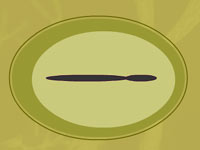
|
|
1. In the beginning
This new, healthy yeast cell has split off from her "mother" and will
soon mature to have "daughter" cells of her own. The black element represents
the cell's chromosomes.
Did you know?
Under normal conditions, yeast cells only live a few days and produce about 20
offspring. By the time an average yeast cell dies, it will have more than a
hundred quintillion descendants (that's one followed by 20 zeroes).
|

|
|
2. The daughter
Once her chromosomes replicate themselves, the daughter yeast becomes a mother
cell herself (center), dividing to produce her own daughter (underway in upper
left). Every daughter cell takes on one copy of her mother's DNA, making the
two cells identical.
Did you know?
Some kinds of yeast can mate. Although most yeasts reproduce asexually as shown
here, haploid yeast cells, which carry half a yeast's genetic material, will
attract each other with pheromones, fuse together to make one cell, exchange
genetic information, and have offspring.
|
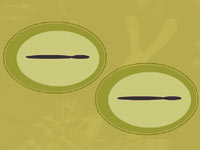
|
|
3. Separate treatments
To test the effects of SIR2, biologist David Sinclair and colleagues fed one
daughter cell (left) a normal diet of glucose while putting the other (right)
on a regimen of 30-40 percent fewer calories. This critical decrease in
nutrition triggered SIR2's emergency responses, which are designed to preserve
the hungry yeast in stressful situations.
Did you know?
Recent scientific findings show that SIR2 can be activated chemically. This
means that—with researchers' help—yeast can have their glucose and
eat it, too, so to speak, reaping the benefits of calorie restriction without
the brutal diet.
|
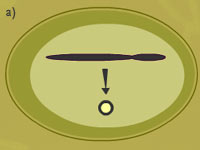
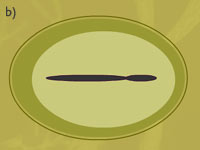
|
|
4. Staying young
As the two yeast cells in this study begin to age and reproduce, the
control yeast—the one eating the normal amount of food—begins to
show signs of decline. Her DNA loses its structure, becoming loose and
combining with itself in ways it shouldn't. Such behavior can cause cancer in
humans, but in yeast forces "circles" of repetitive waste DNA—called
extrachromosomal rDNA circles, or ERCs for short—to pop out of the
chromosomes.
In contrast, the yeast cell with activated SIR2 (invisible inside the
chromosome) remains young at this stage. Her DNA retains its structure thanks
to the SIR2, thus slowing the formation of waste DNA.
Did you know?
Under normal conditions, healthy yeast can live up to two days. Thus, if one
human year equals seven dog years, then one human hour is about four "yeast
years."
|
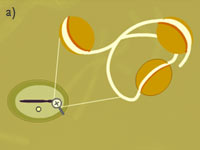
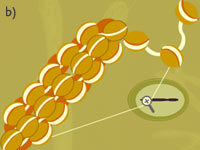
|
|
5. Histones
Looking closely at the middle-aged yeast's genetic material, the DNA
(the white "spaghetti") is literally coming loose after repeated replication.
Chemical tags called acetyl groups that form naturally on the histones (the
brown "meatballs") get in the way of the histones' binding tightly to the
DNA. In the yeast cell on the low-calorie diet, SIR2's enzyme clips the
acetyl groups off of the histones. This allows the proteins to remain firmly
attached to the DNA. With little room to move around, the DNA remains intact,
preventing the formation of ERCs and keeping the yeast cell young and
healthy.
Did you know?
Thanks to resveratrol, found in red wine and peanuts, and some synthetic
molecules, we now know that SIR2 and SIRT1 can be activated chemically. But
don't break out the merlot just yet—you would have to drink as many as
1,000 bottles of wine per day to get the amount of resveratrol given to mice in
a recent study of Sinclair's.
|
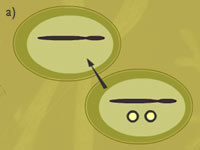
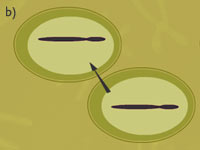
|
|
6. Staying alive
As the aging mother cell continues to replicate her genome, her
copied chromosomes separate to form new, healthy daughter cells. The waste ERCs
usually remain inside the mother's nucleus but can occasionally move to the
daughter cells, too, causing premature aging in those younger cells. At this stage, the special histone proteins attracting and condensing
the SIR2-activated yeast cell's DNA continue to keep their grip. The hungry
mother cell still looks youthful compared to the well-fed control cell.
Did you know?
Yeasts age a lot like we do. Young yeasts are round and smooth, but as they get
older, the cells begin to deteriorate. They become slower-moving and wrinkled,
even sterile.
|
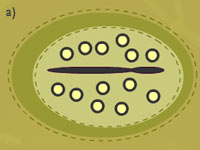
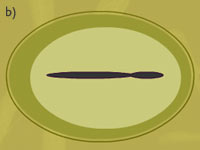
|
|
7. Death of a yeast
After about 20 divisions, the control yeast nears the end of her
life. The useless ERCs take up so many resources that the mother cell can no
longer replicate her own genome and will die. The SIR2-activated yeast shows only minor signs of aging at this
point, if any at all. She will continue to thrive for 10 or more divisions,
soon forming ERCs that will lead to her own demise.
Did you know?
Yeast cells get bigger as they age, holding more than 1,000 waste ERCs as they
near death. That is more DNA than exists in any yeast cell's actual genome.
|

|
|
The human factor:
What all this means for us
"When we started working on yeast aging 20 years ago, we were laughed at by
most," says David Sinclair, an associate professor of pathology and researcher
of aging at Harvard Medical School. "But today we now know that there are
certain genes that control lifespan (called 'longevity genes') and that these
genes could change the course of medical research as we know it. We appear to
be on the verge of understanding if and how these genes affect aging and
age-related diseases in humans. If it is true that longevity genes control
human health and lifespan, we might be able to make drugs that activate these
ancient pathways and use them to treat diseases of aging, such as cancer, heart
disease, diabetes, and even Alzheimer's disease. Such drugs might one day allow
us to live healthy, productive lives into our 90s and beyond."

|
|
|














